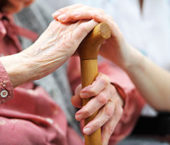In the living room, a grandfather laughs and plays video games with his granddaughters. Later, he joins the rest of his family to say grace before enjoying a meal together. Moments like these may seem ordinary to most. Would it surprise you to know that this grandfather, Robert, is dying and on hospice care?
Many people think that being on hospice means lying in a bed, barely conscious. Robert is a patient who proves that is not case. Many of his final moments were anything but ordinary, and they would not have been possible without the help of hospice.
Robert’s experience is not unique. The mission of Karen Ann Quinlan Hospice is to provide specialized care for end-of-life patients and their families. More simply, hospice care supports living one’s life to the fullest with dignity regardless of how much time remains.
When Robert was diagnosed with cancer, he “wondered if there was any chance of getting my quality of life back while I was still alive.” His answer, “I knew at that moment it was time to call hospice.”
Here are some of the common myths of hospice that need to be put to rest:
MYTH: Hospice care means leaving home.
FACT: Hospice services can be provided in a patient’s own home, a nursing home, long-term care facility or a hospice care center.
Hospice is not a place. In fact, hospice services can be provided to a terminally ill patient and his or her family wherever they are most comfortable, or wherever they consider “home.” Robert’s wish was to make sure he was able to stay home at the end of his life. Hospice made it possible for Robert’s son, Eric, and his family to move into Robert’s home and enjoy dinner together four to five times each week.
MYTH: Hospice means forgoing all medical treatment.
FACT: Hospice nurses and physicians are experts in the latest medications and devices for pain and symptom relief.
In every case, a hospice provider will assess the needs of the patient, deciding which medications and equipment are needed for maximum comfort. For example, Robert’s medical staff provided sleep medication to help him through the night. “I am speaking from the heart when I say hospice provides not only superb medical care, but also offers compassion that I would not have gotten anywhere else,” Robert said.
MYTH: Hospice means strangers care for you.
FACT: Hospice provides a dedicated team of specialists to suit the needs of each patient and educate family members to serve as caregivers.
Hospice organizations strive to educate family members to serve as the primary caregivers for an end-of- life patient. In addition, “The doctors, nurses, aides, social workers, therapists and chaplains who make up my hospice team are there whenever I need them,” Robert said, “All I have to do is pick up the phone and someone from hospice is there to help.”
MYTH: Hospice care ends when someone dies.
FACT: Hospice organizations offer bereavement services for all ages.
Hospice counseling services that deal specifically with grief and coping after the loss of a loved one are available at no cost for up to a year after someone dies. Robert’s son, Eric, credits hospice as something that he and his family can always look back and reflect on in a positive way.
MYTH: People on hospice are in bed, waiting to die.
FACT: Hospice enables special moments and memories at the end of a life that would otherwise not happen.
Robert called hospice because he wanted to live happily and with dignity, restoring a quality of life that he would have otherwise lost to invasive treatments and surgeries. In a final letter chronicling his hospice experience, Robert wrote, “If I inspire others to call hospice, I know I’ve made a difference.”
To learn more about how hospice can help you and your family please call Karen Ann Quinlan Hospice at 973-383-0115.

